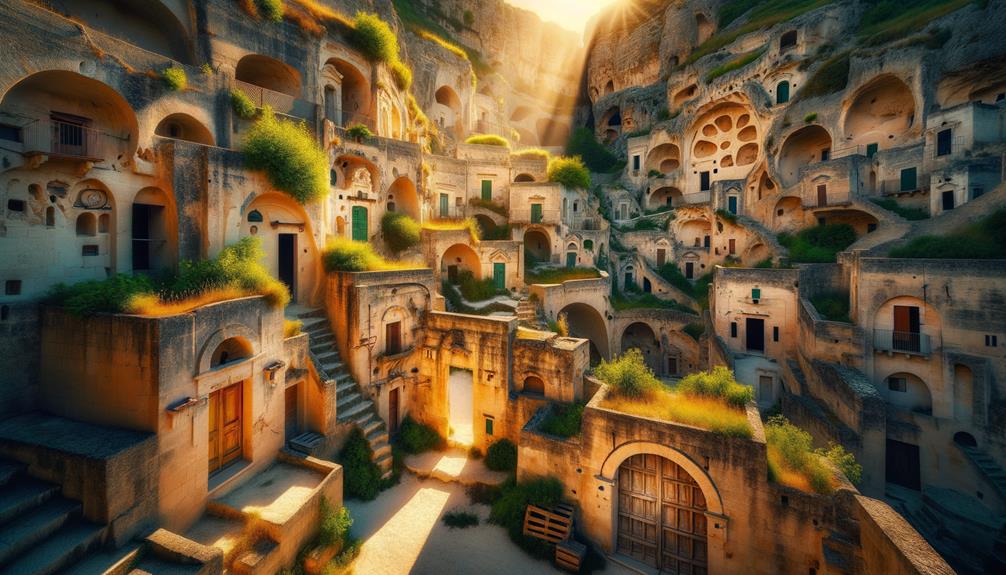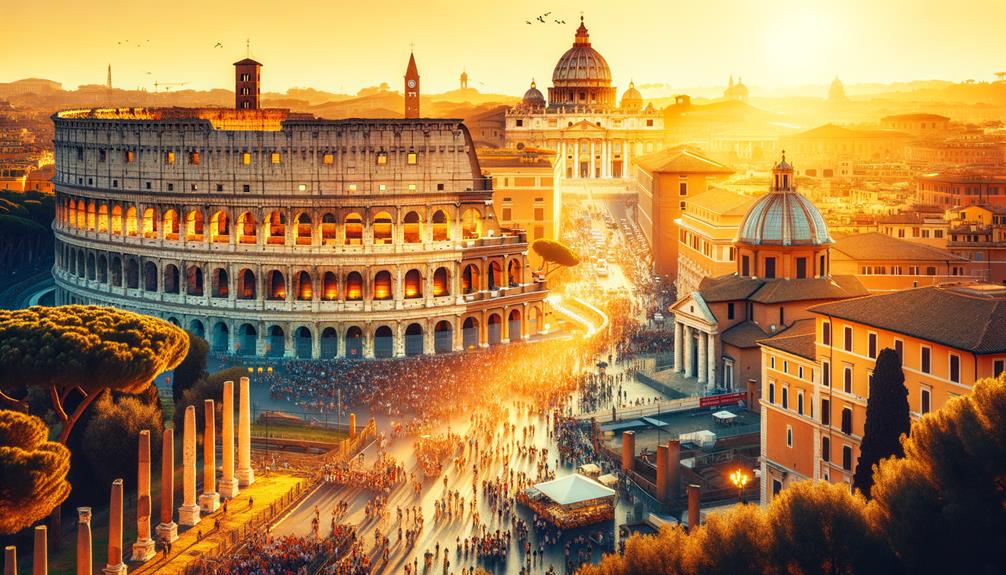Strolling through Matera's Sassi district feels like turning the pages of an ancient book, with each corner revealing a new story. I stepped into one of the 1,500 cave homes and was amazed to learn that 70% of this underground world is hidden below ground. These limestone homes feature Byzantine frescoes, and the narrow alleys lead to cozy restaurants and shops. It's incredible how history and modern life blend seamlessly here, making it a living museum. But what really caught my attention was the tale behind the Crypt of Original Sin, often called the 'Sistine Chapel of cave churches.'
History of the Sassi
The Sassi district in Matera, Italy, with its 1,500 cave dwellings, stands as a testament to human ingenuity and adaptability, deeply rooted in classical and medieval history. Strolling through this maze of ancient caves, carved into the steep sides of a ravine, you can't help but marvel at the story of survival and creativity they tell. The Sassi, now a UNESCO World Heritage site, captures the essence of southern Italy, where communities flourished in sync with their rugged surroundings.
These cave homes, known as 'rupestrian' dwellings, were gradually expanded by peasants and artisans over the centuries. What started as simple shelters evolved into complex living spaces, complete with Renaissance-era structures. It's surprising to learn that only 30% of these homes are visible on the surface, hiding an extensive underground world.
In the 1950s, the Sassi was deserted and left empty. However, recent renovations have revitalized the area, mixing its ancient charm with modern comforts. As I wandered through, I felt a deep connection to the past and a newfound appreciation for how Matera's history has shaped its lively present.
Exploring Sassi Barisano
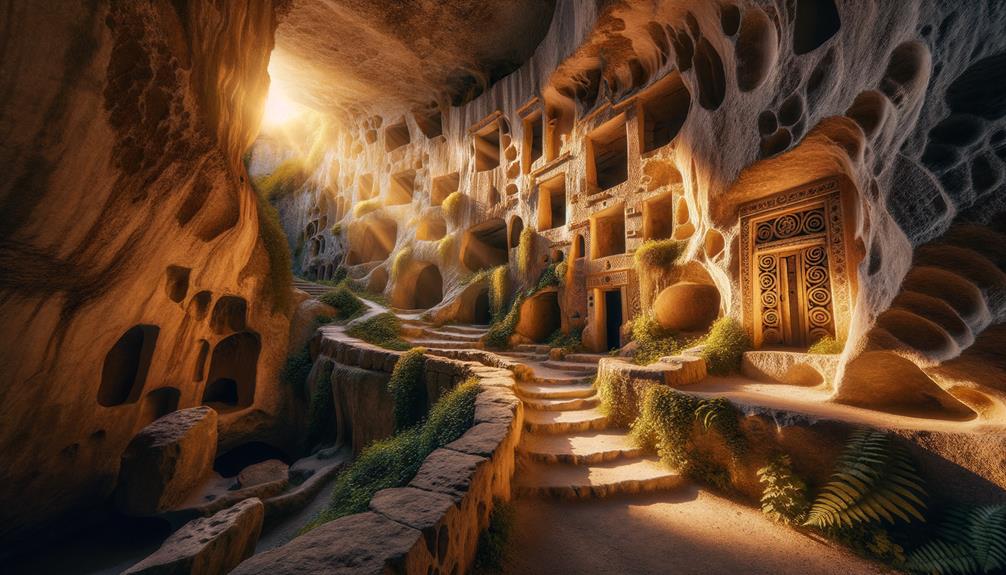
Strolling through Sassi Barisano, I was struck by how ancient cave structures blend effortlessly with modern touches. The narrow alleys and steep stairways lead to cozy restaurants, shops, and hotels carved into the rock. Each step offers a glimpse into history, from Byzantine frescoes in the Church of San Pietro Barisano to the Paleolithic markings on the walls.
Ancient Cave Structures
In the heart of Matera, the Sassi Barisano district opens up a maze of ancient cave dwellings carved from limestone. Each turn presents something new, from the honeycombed structures that shape the skyline to the detailed stone stairways and arches. Walking through, it's easy to get lost in the history embedded in every surface. With over 1,500 homes dug into the sides of a steep ravine, it's like stepping back in time.
The rupestrian churches, such as the Church of San Pietro Caveoso and the Church of Santa Maria de Idris, are especially impressive with their Byzantine frescoes. The atmosphere is both sacred and tranquil, reflecting the essence of southern Italian culture.
Today, many of these spaces have been transformed into cave hotels and restaurants that blend ancient charm with modern comforts. This mix of old and new creates a one-of-a-kind experience.
- Detailed stone stairways and arches
- More than 1,500 cave dwellings
- Rupestrian churches with Byzantine frescoes
- Maze-like passages
- Blend of ancient and modern in cave hotels and restaurants
The Sassi Barisano district is a true testament to Matera's rich heritage.
Modern Adaptations
In Sassi Barisano, you can explore cave hotels and restaurants that beautifully blend ancient history with modern luxury. Walking through this area, you'll be struck by the detailed stonework from the Renaissance, complete with carved stairways and archways that have been carefully restored. Boutique hotels like Le Dodici Lune and Fra i Sassi Residence offer a memorable stay. Each renovated cave combines old walls with sleek, modern touches.
I was amazed by how these cave hotels come with all the modern amenities you might need, including Wi-Fi. It's surreal to be checking emails in a space that once sheltered families centuries ago. The restaurants are equally impressive, offering top-notch dining within these historic walls. Every meal feels like a journey through time, all while enjoying contemporary cuisine.
The Sassi District is a great example of creative repurposing. Cafes, galleries, and even clubs have popped up in these ancient spaces, showing a perfect blend of old and new. Here, history isn't just something you see—it's something you live and breathe, wrapped in modern comforts.
Sasso Caveoso Attractions
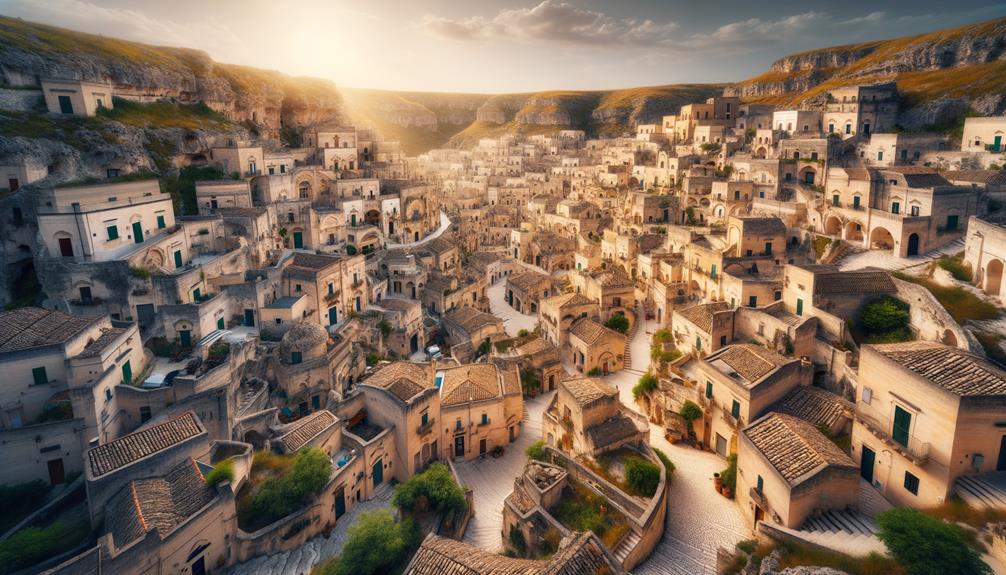
Strolling through Sasso Caveoso, I was struck by the maze of narrow streets and staircases, each turn bringing me to another historical gem like the beautiful Church of San Pietro Caveoso. The area buzzed with a mix of old architecture and modern life, with renovated cave homes now serving as cozy hotels and lively restaurants. I couldn't help but try the local dishes, each bite giving me a taste of Matera's deep cultural roots.
Historical Landmarks Exploration
Walking through the Sasso Caveoso district is like entering a living museum, where ancient cave dwellings and historical sites blend with modern culture. As I wandered the Sassi of Matera, the deep history reflected in every stone drew me in. The cave churches, like the 13th-century San Pietro Caveoso, provide insight into the spiritual life of this old settlement. Its beautiful frescoes and architecture showcase the lasting faith of the locals.
Another gem is the Church of Santa Maria de Idris, a 12th-century church carved into the rock, featuring Byzantine frescoes and detailed decorations. The artwork in these cave churches highlights the rich cultural heritage of Matera.
I also visited the Casa Grotta di Vico Solitario, an 18th-century cave home that has been carefully restored. It offers a close-up view of the daily lives of ancient Materans, complete with traditional furniture and household items.
San Pietro Caveoso
Church of Santa Maria de Idris
Casa Grotta di Vico Solitario
Museum of Contemporary Sculpture
Atmospheric renovated cave restaurants and hotels
Every corner of Sasso Caveoso breathes history, making a visit here an unforgettable experience.
Unique Cultural Experiences
Wandering through the winding alleys of Sasso Caveoso, I was struck by how ancient traditions and modern comforts come together in the renovated cave restaurants and hotels. Each step in this fascinating part of Matera revealed another layer of cultural richness.
When I visited the landmark churches of San Pietro Caveoso and Santa Maria de Idris, the stunning Byzantine frescoes and intricate decorations captivated me, telling stories from centuries ago. The sense of history was everywhere, yet the neighborhood buzzed with a contemporary vibe.
The Museum of Contemporary Sculpture, set in a 16th-century cave palazzo, was a surprising treat. The contrast between modern art and ancient stone walls created a unique atmosphere, making each piece feel like a conversation between different times.
A standout moment was visiting Casa Grotta di Vico Solitario, a reconstructed 18th-century cave home. Walking through its rooms, I felt deeply connected to the daily lives of Matera's past inhabitants. The neighborhood's narrow alleys and stairways, lined with charming shops, cafes, and trattorias, offered a vivid glimpse into Matera's rich cultural heritage.
In Sassi, every corner turned revealed a new discovery, a new story waiting to be told.
Local Culinary Delights
Sasso Caveoso is a food lover's paradise, where I enjoyed the authentic flavors of traditional Lucanian dishes in charming, family-owned trattorias. As I meandered through the narrow streets of Matera, I discovered quaint restaurants offering a genuine taste of the region. One standout experience was trying the famous 'focaccia di Matera,' a flatbread topped with olive oil, tomatoes, and capers. The simplicity of the ingredients came together to create an unforgettable taste.
Places like Trattoria del Leone and Trattoria Osà showcase the authenticity of local cuisine. These eateries pride themselves on using fresh, locally-sourced ingredients, making every dish a homage to Lucanian culinary traditions. The local market, Mercatino di Sasso Caveoso, also drew my attention. There, I found a variety of regional products, from cheeses and cured meats to unique handicrafts.
As evening fell, Sasso Caveoso buzzed with live music and entertainment. Sipping on a glass of local wine or enjoying a traditional Italian coffee was the perfect way to end my culinary adventure.
- Focaccia di Matera
- Trattoria del Leone
- Trattoria Osà
- Mercatino di Sasso Caveoso
- Live music and entertainment
Frescoed Rock Churches
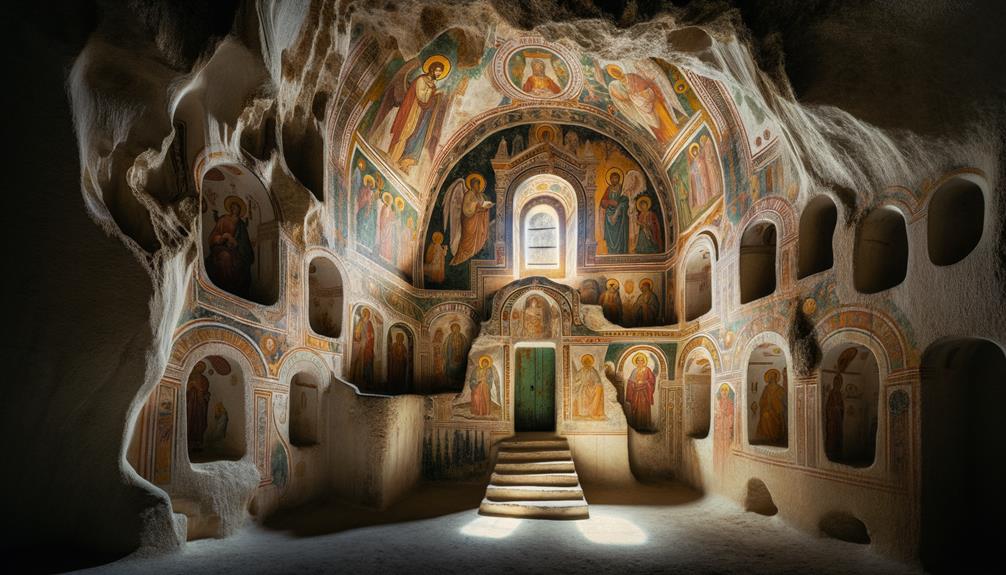
Set within the rugged landscape of Matera's Murgia Plateau, the frescoed rock churches offer a captivating look into the region's rich spiritual and artistic past. Walking through the uneven terrain, I'm struck by the sheer number of caves, each a testament to the ancient rupestrian culture. These sanctuaries, often called Matera's Sistine Chapel, are adorned with stunning Byzantine frescoes that have endured through the ages.
Entering one of these caves, I'm immediately drawn to the vibrant biblical scenes on the walls. The frescoes, with their lively depictions of the Virgin Mary and various biblical figures, narrate stories passed down through generations. It's as if the walls themselves are whispering ancient tales of faith and devotion.
The beauty of these frescoes lies not just in their artistry but in their ability to transport me back in time. Every brushstroke and color reveals a piece of history, a glimpse of the spiritual life that once thrived here. The journey through these frescoed rock churches is more than just a visual treat—it's a deep connection to the past.
Crypt of Original Sin
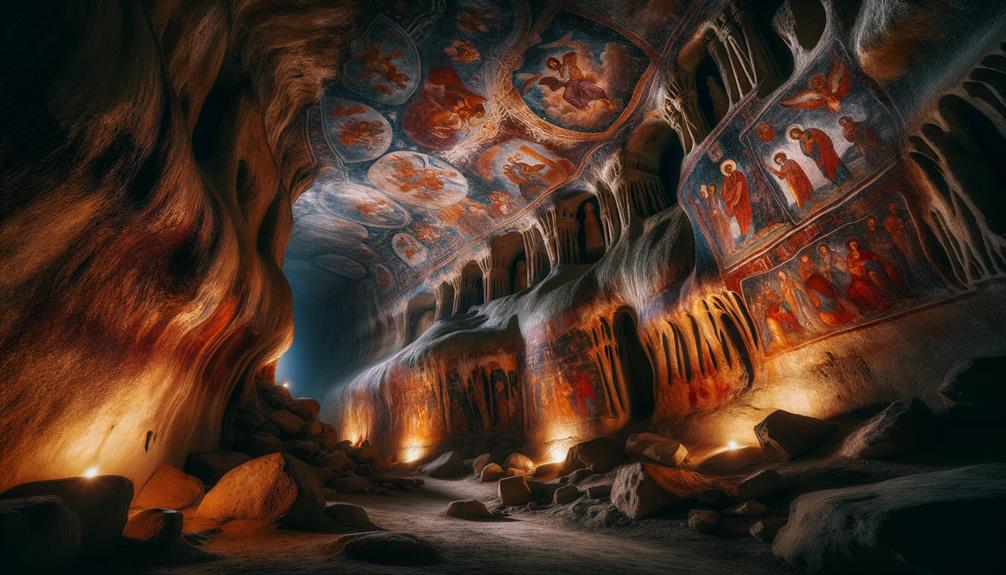
Leaving behind the frescoed rock churches, I find myself irresistibly pulled to the stunning Crypt of Original Sin. Known as 'The Sistine Chapel of Rupestrian Art,' this sanctuary is about 1,000 years old. Located on the Murgia plateau of Matera, its walls boast some of Italy's best-preserved Byzantine art.
The frescoes are mesmerizing with their vivid colors and intricate details. Scenes of Adam and Eve, God the Creator, the archangels, and the Virgin Mary transport me to another era. Standing before these masterpieces is a humbling experience, knowing they've survived for a millennium.
Finding the crypt in a natural cave feels like uncovering a piece of long-lost history now cherished. Restoration efforts in the 1960s have ensured that future generations can marvel at these treasures.
- The crypt's vibrant frescoes
- Depictions of biblical figures
- Preservation of Byzantine art
- Historical restoration in the 1960s
- Located in Matera's Murgia plateau
Each step further into the Crypt of Original Sin deepens my appreciation for Matera's rich cultural and artistic heritage. This site stands as a testament to human creativity and devotion, etched in stone for eternity.
Matera's Hollywood Connection
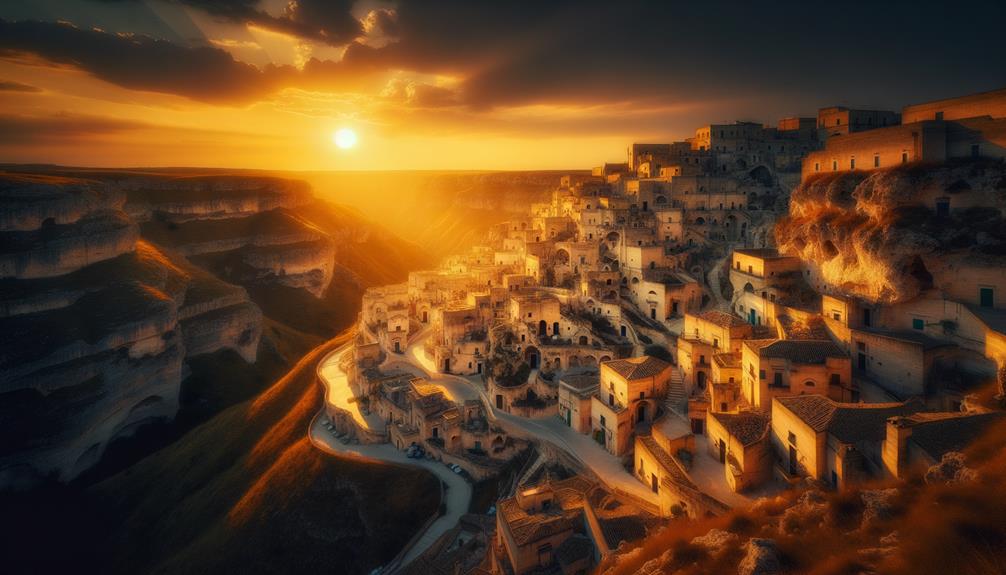
Matera's cinematic charm has transformed its ancient cave dwellings into iconic settings for some of Hollywood's most memorable films. As you wander through the narrow streets and admire the rock-carved churches, you can almost feel the presence of past film crews. Pier Paolo Pasolini's 'The Gospel According to St. Matthew' was the first to showcase Matera's stunning landscape to the film industry. Pasolini chose Matera for its timeless feel and raw beauty, which perfectly captured the essence of the Gospel.
Years later, Mel Gibson's 'The Passion of the Christ' brought even more attention to this fascinating place. Gibson's intense portrayal of Christ's final hours was enriched by the haunting atmosphere of Matera's caves. It's easy to see why filmmakers are drawn here—the ancient stones seem to be alive with history.
More recently, Matera's caves appeared in 'Ben-Hur,' 'Christ the Lord,' and the James Bond film 'No Time to Die.' Each film has left its mark, embedding Matera into the annals of movie history. This Hollywood connection has not only boosted Matera's tourism but also deepened its cultural significance, making it a must-visit for curious travelers.
Frequently Asked Questions
Why Did People Live in Caves in Matera?
Why did people live in caves in Matera? Think about finding a refuge from the hustle and bustle of everyday life. The natural insulation of the caves made them comfortable, while the close-knit community offered a sense of belonging and freedom from the usual societal pressures.
Do People Still Live in Sassi Di Matera?
Yes, people still live in Sassi di Matera. As I walked through the ancient streets, I met locals who have held onto their family homes. Their determination to stay, even as the area changes, is truly inspiring. Though their numbers have dwindled, their presence keeps the soul of Matera vibrant.
How Old Are the Houses in Matera, Italy?
The houses in Matera are incredibly old, with a history stretching back over 9,000 years. Walking through this ancient city, you can't help but feel the enduring presence of human life carved into the rock, a testament to resilience and freedom.
What Is the Shame of Italy, Apulia?
The phrase "shame of Italy, Apulia" refers to the difficult past of Matera, where people lived in extreme poverty and very poor conditions. It's amazing to see how the city has turned things around and is now a UNESCO World Heritage Site, proudly showcasing its rich history.

